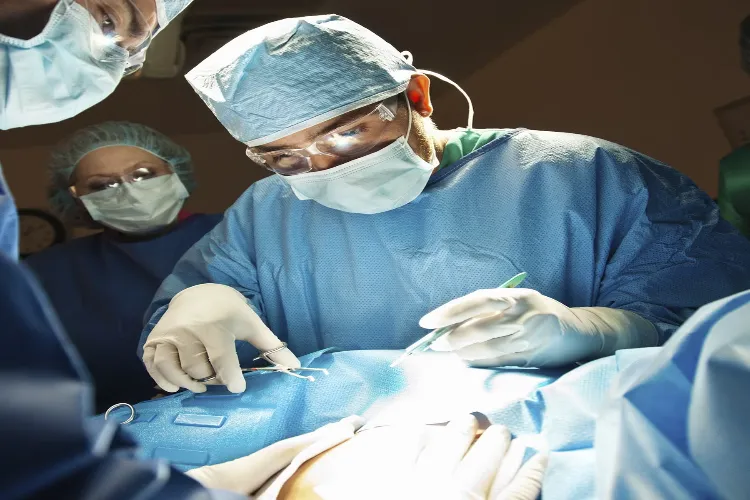
Chennai
The Indian Institute of Technology Madras (IIT Madras) researchers have found a sharp uptick in the number of caesarean section (C-section) deliveries that took place across the country between 2016 and 2021.
A caesarean section (C-section) delivery is a surgical technique that involves making an incision in the mother's belly to deliver one or more infants.
When medically justified, the procedure can be lifesaving. When not strictly necessary, however, it can cause several adverse health outcomes, lead to unnecessary expenditure, and place a strain on scarce public health resources.
Factors that could contribute to adverse birth outcomes and possibly justify C-sections (such as the mother's age being less than 18 years or greater than 34 years, the interval between births being less than 24 months or the child being the fourth or more born to the mother) are considered high-risk fertility behaviour.
In an in-depth analysis of Tamil Nadu and Chhattisgarh, the researchers found that despite the fact that both pregnancy complications and high-risk fertility behaviour were more prevalent in Chhattisgarh, Tamil Nadu had a higher prevalence of C-sections.
"A key finding was that the place of delivery (whether the delivery was in a public or a private facility) had the greatest impact on whether the delivery was by C-section, implying that 'clinical need' factors were not necessarily the reason for surgical deliveries.
Across India and Chhattisgarh, the non-poor were more likely to opt for C-sections, while in Tamil Nadu, the case was surprisingly different, as the poor were more likely to have C-sections in private hospitals," Prof VR Muraleedharan, Department of Humanities and Social Sciences, IIT Madras said, elaborating the importance of these findings and its implications for health policymakers in the country.
"The prevalence of C-sections across India increased from 17.2% to 21.5% in the five years leading up to 2021. In the private sector, these numbers stand at 43.1% (2016) and 49.7% (2021), meaning that nearly one in two deliveries in the private sector is a C-section.
This increase could be attributed to several factors. The researchers found that better-educated women living in urban areas were more likely to deliver by C-section, suggesting that greater autonomy and better access to healthcare facilities play a role in the increase in prevalence of C-sections." Reads study
"The odds of caesarean delivery among overweight women and those aged 35-49 were twice those for underweight women and those aged 15-24, respectively. The proportion of overweight women giving birth increased from 3% to 18.7%, while that of women aged 35-49 decreased slightly from 11.1% to 10.9%.
Significantly, the proportion of those with pregnancy complications decreased from 42.2% to 39.5%, implying that the increased rate of C-section delivery was largely influenced by non-clinical factors. Women's own preferences, their socio-economic level and education, and risk-averse physicians practising conservative medicine could be some of these non-clinical factors." It said further.
Overall, in India, women delivering at private healthcare facilities were four times more likely to have a C-section over the period of study between 2016-2021. In Chhattisgarh, women had a ten-times higher chance of delivering by C-section in a private hospital while in Tamil Nadu, they had a three-times higher chance.
This could be due to a lack of adequate infrastructure in public healthcare facilities, the researchers highlight - in Chhattisgarh, there was a 77% vacancy against the sanctioned posts for obstetricians and gynaecologists in 2021.
To arrive at the above conclusions, the researchers collated and analysed data from the National Family Health Survey (NFHS) conducted in 2015-2016 and 2019-21. The NFHS is a national survey that generates data on population and health indicators, especially on maternal and child health, which is conducted across India.
According to the World Health Organization (WHO), the recommended rate for C-sections is between 10% and 15%.
"Threshold levels for C-sections should be applied cautiously, as several inter-category variations exist, and in states at advanced levels of demographic transition, need factors for C-sections may be more prevalent. There is an alarmingly high proportion of poor women undergoing C-sections in the private sector in Tamil Nadu. This requires further analysis and corrective action in case some of these are clinically unnecessary," said researchers.
ALSO READ: Rescued Pakistanis say Indian Navy dealt with Somali pirates all night
The peer review study was undertaken by researchers from the Department of Humanities and Social Sciences at IIT Madras. They include Varshini Neethi Mohan and Dr P Shirisha, Research Scholars, Dr. Girija Vaidyanathan and Prof. V R Muraleedharan.
